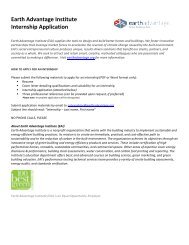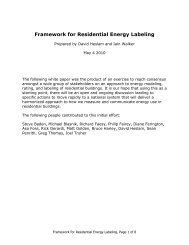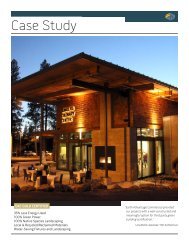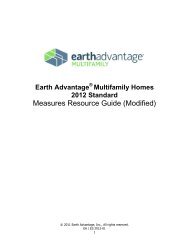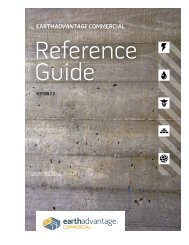EA New Homes Measures Guide - Earth Advantage
EA New Homes Measures Guide - Earth Advantage
EA New Homes Measures Guide - Earth Advantage
You also want an ePaper? Increase the reach of your titles
YUMPU automatically turns print PDFs into web optimized ePapers that Google loves.
2012 <strong>Earth</strong> <strong>Advantage</strong> Residential<br />
<strong>Measures</strong> Resource <strong>Guide</strong><br />
3.10.1<br />
Accountability Form: General Energy Health Land Materials Water<br />
Recycled Content Insulation: Cellulose, Cotton or Fiberglass (25% - 50% / 0 0 0 1/2 0<br />
51% and greater Post-consumer) (20-50% / 51-100%)<br />
Description: Insulation must meet one of two post-consumer recycled content thresholds: 25 - 50 percent or greater than 50 percent. At<br />
least all of one component is to meet this spec to be eligible for the points (i.e., floors, walls or ceilings).<br />
Benefit: Cellulose: Cellulose insulation is made from a minimum of 75 percent post-consumer recycled paper, typically from phone books<br />
or newspaper, treated with borate that repels insects, deters mold, and resists fire. Cellulose is a loose material that can be dry-blown or<br />
dense-packed into enclosed cavities, or wet-sprayed into open wall cavities. It is commonly blown into attics. Because of it is blown in, it<br />
fills spaces well. This feature improves its energy efficiency by preventing cold spots in the building shell. This limits the pressure on scarce<br />
natural resources, as well as the demand for space in local landfills. Cellulose may also lower the overall embodied energy of the home if<br />
used instead of insulation made from virgin materials.<br />
<br />
Cotton: Cotton insulation is made from 100 percent post industrial recycled cotton. The insulation comes in batt form and is currently<br />
available in R-13, R-19, R-21 and R-30 products. The benefits are the same as cellulose insulation. <br />
<br />
Fiberglass: All fiberglass insulation contains some recycled content, although the amount and the sources vary between manufacturers. A<br />
product that is made from recycled bottles and other post consumer glass goods helps promote recycling, as well as supplementing the<br />
production of new products by using what was once in the market.<br />
Verification: <strong>EA</strong> Rater will verify the type of insulation present. The amount of post-consumer recycled content for cellulose and cotton will<br />
be assumed to be greater than 50 percent. The builder or responsible party will sign an Accountability Form attesting to the recycled<br />
content of the product.<br />
3.10.2<br />
Blown-in Vaulted Ceiling or Floor Insulation<br />
Energy<br />
Materials<br />
Water<br />
0 0 0 1 0<br />
Description: Blown-in insulation can also be installed in ceilings and floors. To be eligible for points, one component, either vaulted ceilings<br />
or floors, must use this practice. This refers to BIBS, Spider and similar proprietary insulation systems that use either fiberglass or cellulose<br />
material.<br />
Health<br />
Land<br />
Benefit: Blown-in insulation fills the cavity more effectively around obstructions, such as pipes and wires, than batt insulation. This method<br />
also tends to reduce air leakage through the building shell, which is reflected in a better air leakage test (Measure 3.11.1). Becuase it is<br />
installed at a higher density than batts, blown-in insulation has a higher R-value, too.<br />
Verification: <strong>EA</strong> Rater will check to be sure that insulation fills the cavity. If the insulation is installed behind netting, the netting should be<br />
taught and firm to the touch.<br />
Page 26 of 70



